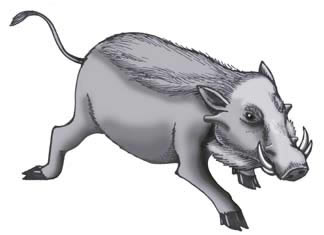

They are found in Africa, south of the Sahara.
They live out on the grasslands (savanna).
They have bristly hairs all over their body, and a mane from the top of their head down the middle of their back. They have a long, thin tail with a tuft at the end. They carry their tail up when they run. The tuft of bristles at the end waves like a flag. Males can weigh more than 200 pounds and are larger (sometimes by 50 pounds) than females. They have very large heads with wide cheek pads called “warts.” They have 2 sets of tusks. The upper tusks come out the sides of their snout curving around inward. The lower tusks are smaller, with a dangerously sharp edge.
They are active during the day (diurnal) and sleep in an underground den at night. Males live alone except to mate. Females live in family groups with young and sometimes other females and young. They find or dig holes in which to sleep. This helps them keep cool during the day and warm at night. When startled, a warthog grunts and runs for cover.
They eat grass, even kneeling to get to the shorter grass. They are especially adapted for this with padded knees. They sniff for bulbs and roots and use their sharp tusks to dig them out. They sometimes eat earthworms, insects and other small animals.
They are killed by lions, leopards, cheetah, hyenas and man.
Females are pregnant for 6 months (gestation), but before she gives birth she goes off by herself and finds a secluded den. She may have to chase off her last litter. She then has her 3-4 piglets in the underground den. They can start eating grass by about 3 weeks old.
They can live up to 12 years in the wild. They are not a threatened species.
Kingdom: Animalia
Phylum: Chordata
Subphylum: Vertebrata
Class: Mammalia
Order: Artiodactyla
Family: Suidae
Subfamily: Suinae
Genus: Phacochoerus
Species: Phacochoerus aethiopicus
When you research information you must cite the reference. Citing for websites is different from citing from books, magazines and periodicals. The style of citing shown here is from the MLA Style Citations (Modern Language Association).
When citing a WEBSITE the general format is as follows.
Author Last Name, First Name(s). "Title: Subtitle of Part of Web Page, if appropriate." Title: Subtitle: Section of Page if appropriate. Sponsoring/Publishing Agency, If Given. Additional significant descriptive information. Date of Electronic Publication or other Date, such as Last Updated. Day Month Year of access < URL >.
Amsel, Sheri. "Warthog" Exploring Nature Educational Resource ©2005-2024. December 15, 2024
< http://exploringnature.org/db/view/456 >

